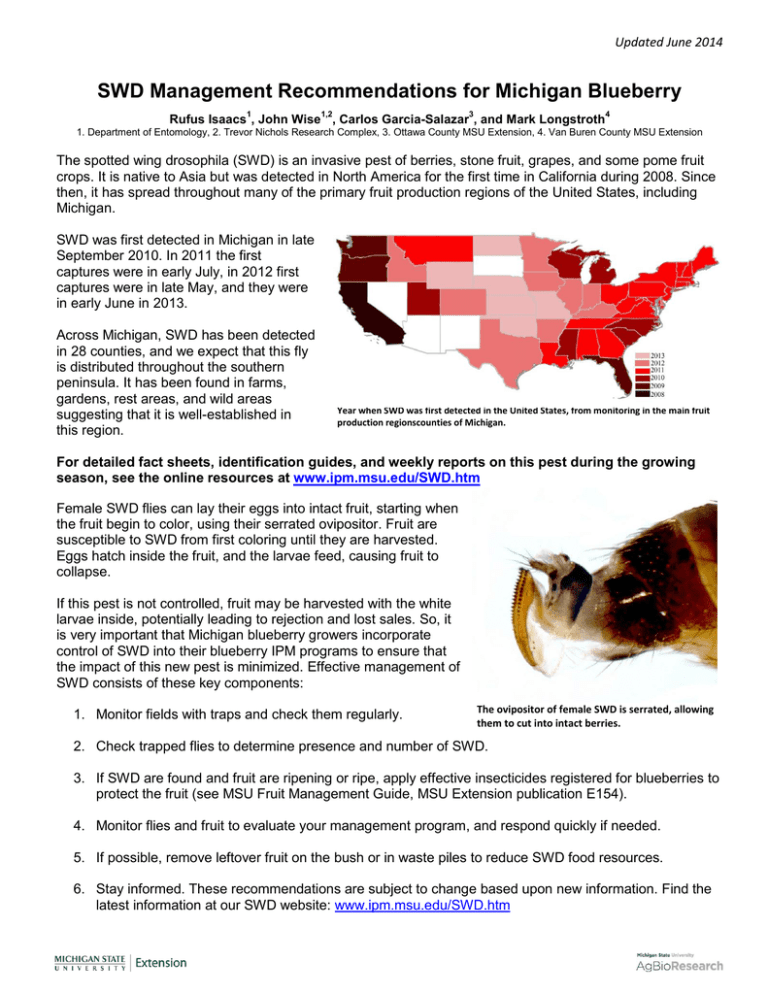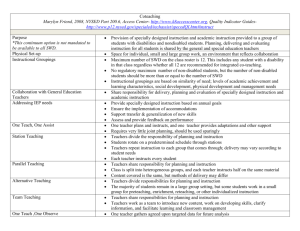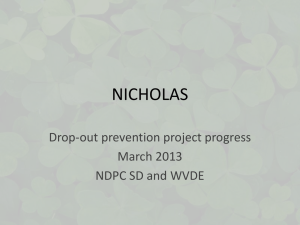SWD Management Recommendations for Michigan Blueberry
advertisement

Updated June 2014 SWD Management Recommendations for Michigan Blueberry 1 1,2 3 Rufus Isaacs , John Wise , Carlos Garcia-Salazar , and Mark Longstroth 4 1. Department of Entomology, 2. Trevor Nichols Research Complex, 3. Ottawa County MSU Extension, 4. Van Buren County MSU Extension The spotted wing drosophila (SWD) is an invasive pest of berries, stone fruit, grapes, and some pome fruit crops. It is native to Asia but was detected in North America for the first time in California during 2008. Since then, it has spread throughout many of the primary fruit production regions of the United States, including Michigan. SWD was first detected in Michigan in late September 2010. In 2011 the first captures were in early July, in 2012 first captures were in late May, and they were in early June in 2013. Across Michigan, SWD has been detected in 28 counties, and we expect that this fly is distributed throughout the southern peninsula. It has been found in farms, gardens, rest areas, and wild areas suggesting that it is well-established in this region. Year when SWD was first detected in the United States, from monitoring in the main fruit production regionscounties of Michigan. For detailed fact sheets, identification guides, and weekly reports on this pest during the growing season, see the online resources at www.ipm.msu.edu/SWD.htm Female SWD flies can lay their eggs into intact fruit, starting when the fruit begin to color, using their serrated ovipositor. Fruit are susceptible to SWD from first coloring until they are harvested. Eggs hatch inside the fruit, and the larvae feed, causing fruit to collapse. If this pest is not controlled, fruit may be harvested with the white larvae inside, potentially leading to rejection and lost sales. So, it is very important that Michigan blueberry growers incorporate control of SWD into their blueberry IPM programs to ensure that the impact of this new pest is minimized. Effective management of SWD consists of these key components: 1. Monitor fields with traps and check them regularly. The ovipositor of female SWD is serrated, allowing them to cut into intact berries. 2. Check trapped flies to determine presence and number of SWD. 3. If SWD are found and fruit are ripening or ripe, apply effective insecticides registered for blueberries to protect the fruit (see MSU Fruit Management Guide, MSU Extension publication E154). 4. Monitor flies and fruit to evaluate your management program, and respond quickly if needed. 5. If possible, remove leftover fruit on the bush or in waste piles to reduce SWD food resources. 6. Stay informed. These recommendations are subject to change based upon new information. Find the latest information at our SWD website: www.ipm.msu.edu/SWD.htm Updated June 2014 MONITORING The most important step in managing SWD is to determine whether they are present in your fields, and when they may become active. Monitoring for SWD from after fruit set until the end of harvest will help identify the start of fly activity. The most important monitoring period is from fruit coloring until the crop is harvested, when the fruit are susceptible to SWD infestation. These flies can be trapped using a simple homemade monitoring trap consisting of a plastic 32oz cup with ten 3/16”-3/8” holes around the upper side of the cup, leaving a 3-4 inch section without holes to facilitate pouring out of the liquid attractant, or bait (Figure). The holes can be drilled in sturdy containers or melted with a hot wire or soldering iron. The small holes allow access to vinegar flies, but keep out larger flies, moths, etc. The traps are baited with a yeast-sugar mix, made by combining 1 Tablespoon of active dry yeast (we use Red Star brand) with 4 tablespoons of sugar and 12 oz of water. This ratio produces a solution that ferments and the flies are attracted to the odors. Comparing this mix to apple cider vinegar, we found that SWD were trapped earlier, more of the traps caught SWD, and SWD was trapped in greater numbers than with the apple cider vinegar. Although these traps are harder and messier to service, the yeast bait is less expensive than the apple cider vinegar traps, and the benefits of earlier detection are obvious when needing to protect crops from infestation. Traps baited with yeast will collect many flies, so sorting through these traps will take more time. Homemade trap for capturing adult SWD flies. For 2014, there is also a new clean bait consisting of two plastic lures that must both be used together for effective attraction of SWD. They come packaged together and are available from Great Lakes IPM. The lures can be hung on paperclips inside the trap. Using these lures (that last 4 weeks) avoids the need for messy yeast and sugar as a bait. They can be used instead with 2 inches of water in the bottom of the trap, with a few drops of unscented dish soap to break the surface tension. If desired, a yellow sticky trap can be placed in the trap to provide a surface for catching the flies. There is also a commercial SWD trap design available from Great Lakes IPM that can be purchased with the SWD lures. For blueberry growers in Michigan who want the best chance of catching SWD, we recommend a minimum of one baited trap for SWD every 5-10 acres. Also focus traps at your likely hot spots such as near woods, creeks, or unmanaged areas of crop of wild host plants. Any traps for SWD should be hung in a shaded area of the bush canopy in the fruit zone, using a wire attached to the top of the trap. Make sure the trap is clear of vegetation with the holes exposed so that SWD can easily fly in. Traps should be checked for SWD flies once a week at a minimum, by looking on the yellow sticky trap and in the liquid. Change the yeast-sugar bait weekly or the commercial lures once a month. Spotted wing drosophila captures should be recorded each week in a log book. Commercial lures (left) that are provided in a pair, and which can be hung inside the trap for attracting adult SWD flies. Updated June 2014 SWD IDENTIFICATION Vinegar flies are small (2-3 mm) with rounded abdomens. Traps catch both male and female SWD flies, and native species of vinegar flies. This means that SWD need to be distinguished from the others when checking the traps. Identification of SWD flies becomes easier with practice, especially when using a hand lens or microscope. Some native flies have dark patches on the wings, but will not have the distinctive dark dot that is present on the wings of SWD males, so it is impoerant to be able to separate SWD from the look-alikes. Male SWD have a distinctive spot on each wing (right panel photo). In contrast, female SWD (left panel) do not have dots on the wing, so their ovipositor needs to be examined closely in search of its serrated characteristics. Use a 30X magnification hand lens or microscope to detect the distinctive saw-toothed ovipositor on female SWD. This is challenging to detect, so we recommend that people familiarize themselves with the distinctive features for identifying L-R: a female SWD with the ovipositor highlighted; a ‘look-alike’ Drosophila fly; and a male SWD. SWD. The photos here show a female SWD next to a female of another species. Note the ovipositor marked with a green oval. A photographic guide to identifying SWD is provided at the MSU SWD website (www.ipm.msu.edu/swd.htm). If a trap catches flies matching these descriptions, but you are unsure of their identification, contact your local MSU Extension office or a trained scout or crop consultant for assistance. If local assistance is not available, we encourage people to place flies into a container that will prevent them being squashed, and send them for identification to: Howard Russell, SWD Monitoring, Diagnostic Services, 101 CIPS, 578 Wilson Road, Michigan State University, East Lansing, MI 48824-1311. Include the location and date of collection along with your contact information. Further aid with identification can be gained from the online key provided by Oregon Department of Agriculture at swd.hort.oregonstate.edu/files/webfm/editor/ID_D_suzukii_060210_sm.pdf Updated June 2014 SAMPLING FRUIT FOR SWD LARVAE If fruit are suspected of being infested by SWD, larvae can be sampled using a fruit dunk flotation method. Either collect a standard sample of fruit, or only suspicious (oviposition scars and soft spots) fruits. If you are sampling in fields, place fruit in a plastic “ziplock” bag and crush lightly to break the skin. Add a salt solution (1 cup salt per gallon of water). Leave the fruit in the mixture for 15 minutes, then check it. Drosophila larvae will float in the liquid making them easier to see, plus they should be visible as small white larvae against the blue colored liquid. Detection of small larvae may require the use of a hand lens, and this works well with a light behind the bag to shine through onto the larvae. If this is being done indoors, place suspect berries on a tray and pour the salt solution over the lightly crushed fruit. Observe the fruit after an hour to see if larvae are present. Note that this method doesn’t allow for differentiating between SWD larvae and other similar species. The only SWD larvae emerged from fruit and floating in a strong way to be sure larvae in the fruit are SWD is to rear salt solution them until they are adult flies. A practical way to do fruit extraction for detecting drosophila larvae is to mix a large jug of the salt solution to keep on hand, in a truck or back at the barn. Then take fruit samples into ziplock bags marked with the date and field. Once samples are taken, lightly crush the berries and add the solution. Hold the samples up to the light to look for larvae, after at least 15 minutes exposure to the salt solution. Berries can also be sampled using the standard boil test used by processors for blueberry maggot detection. To do this, cover a sample of berries with water and boil for one minute then pour the fruit and liquid onto a mesh-covered frame over a tray and mash the fruit with the back of a spoon. Lightly wash through with water and look in the tray for larvae. This method works very well for detecting SWD larvae, which are smaller than blueberry maggot (see photo). It should be noted that young blueberry maggot larvae are difficult to distinguish from SWD larvae, but specimens can be separated based on their shape, and the structure of the larva from features visible under a microscope. Although the boil test is used as a standard sampling method for checking fruit by processors, it would be better to detect any potential infestation in the field and control it before any infestation reaches the processor. Relative size of blueberry maggot larva (top) and SWD larva (bottom). Updated June 2014 SWD CONTROL OPTIONS Given the potential for rapid population increase by SWD, active management through monitoring of flies and fruit infestation is needed until the end of harvest. This will allow rapid response to detections of SWD. Registrations and recommendations change, so keep informed through our website, your local Extension educator, and the MSUExtension News for Agriculture (www.msue.anr.msu.edu/topic/info/fruit). There is no economic threshold for SWD, so we are currently recommending a conservative approach in which fly capture on your farm triggers protection of fields if berries are at a susceptible stage. If fruit are ripe or are ripening and SWD flies are trapped, growers should: 1) Continue monitoring to assess fly distribution; 2) Implement cultural controls where possible; 3) Protect fruit through to harvest using registered insecticides; 4) Consider post-harvest controls including temperature treatment and soft-sorting machinery. Female SWD are able to lay eggs into blueberries from the time of first coloring through harvest. This period is the window of susceptibility to SWD and when management action should be focused. If drosophila larvae are found, the available management options and best strategies will depend on the scale of infestation, whether the field is certified organic or not, and the timing relative to harvest date. Laboratory tests have shown little evidence of highbush blueberry varieties being more or less susceptible to infestation. But, because SWD populations tend to increase in the later part of the summer, we expect late-harvested cultivars to experience higher pressure from SWD than those that are harvested early. For example, in our limited experience, Weymouth, Duke, and early Bluecrop experience less SWD pressure in Michigan than do Elliott, Liberty, and other later cultivars. Cultural controls Cultural controls can help reduce reproduction and survival of flies and should be included in the overall plan for SWD management. Cultural controls include scheduling timely harvests and removing over-ripe fruit from fields and then disposing of them properly, to minimize host plant resources for SWD. In small fields this may be done by hand, but that is impractical in large farms. Removing wild host plants that can harbor SWD such as wild grape, pokeberry, honeysuckle, nightshade, dogwood, spicebush, autumn olive, raspberry, blackberry, etc. near crop fields is another potential strategy, but again this approach has not been tested in our region. From our recent observations, presence of honeysuckle near fields is a predictor of more activity from SWD. We have also observed higher catches in traps adjacent to fields where they remain wet longer, or adjacent to creeks. Improved drainage, fixing irrigation leaks, and understanding this as a potential hot-spot can all aid in SWD management. Solarization can also kill SWD by over-heating the flies. If infested berries are found either in the field or at the processor, there are some strategies for killing SWD before they complete development and emerge to continue infesting fields. Research in Oregon has shown that bagging fruit inside clear or black plastic bags works well to prevent fly escape, and placing these in the sun will kill SWD. If there is a large pile of fruit, these can also be solarized in which 1-2 ml clear plastic sheeting is placed over the fruit in a sunny location and sealed well around the edge using soil. Burying infested fruit is not very effective as flies can survive in the cool soil and emerge, although a recent study in New Jersey indicates burial in 30 cm depth sand prevented emergence. Cold temperatures also have a significant effect on SWD. Freezing berries will kill the larvae and pupae, and this approach works for processing berries. For fresh market berries, refrigeration will stop further development of larvae, and may kill them after long periods of refrigeration. For example, in recent studies in North Carolina, holding o blueberries at 35 F for 3 days led to 100% mortality of eggs in berries, and killed 85, 85, and 74% of the first, second, and third instar SWD larvae, respectively. Keeping berries cool during the supply chain from field to processor to market to customer will also minimize the chance that larvae will develop in berries. Encourage consumers to keep their berries in the fridge. Updated June 2014 Chemical controls Michigan blueberry growers already use IPM programs to manage insect pests (such as the blueberry maggot fly) during the summer months. Many of the insecticides used for this pest will provide some protection against SWD, including the pyrethroid, organophosphate, and spinosyn chemical classes. See below for a discussion of neonicotinoids – these have been very effective for blueberry maggot control, but they are not the first choice for SWD control. It is important to realize that whereas blueberry maggot has only one generation a year and takes a week from emergence to egg-laying, SWD females can start laying eggs one day after emergence. SWD will complete 5-6 generations under typical Michigan conditions and there will be continuous activity once the flies become active. These aspects of the pest biology mean that if SWD flies are active and fruit is ripe, spray intervals need to be tightened from a typical 2 week interval to a 7 day interval. Sprayers should be calibrated to provide thorough coverage of fruit, especially in the center of the bush where the flies like to hide in the shade. This is likely to require spray volumes at or above 30 gallons of water per acre, depending on the sprayer. Applications that attempt to cover several rows at a time are unlikely to achieve sufficient coverage of berries on all the rows. Coverage is also greatly improved by pruning – fields with well pruned bushes have experienced less SWD pest pressure than those with large, dense bushes. A number of registered conventional insecticides have shown to be effective against SWD in recent MSU trials. Insecticides with fast knockdown activity have performed well at protecting berries from SWD. These include Imidan and Malathion (*see note below) which are organophosphate insecticides; the carbamate Lannate; the pyrethroids Danitol, Mustang Max; and the spinosyns Delegate and Entrust (organic). Neonicotinoids such as Provado and Actara are considered weakly active on SWD flies and are not recommended for control. While there is some potential for postinfestation control of small eggs and larvae by the neonicotinoid insecticide Assail, this still has limited contact activity on SWD flies so we would presently only recommend Assail if there is also a need for aphid/blueberry maggot control. It will provide excellent aphid control, and will protect berries against blueberry maggot, and has some activity on SWD. Malathion 8F produced by Gown Company has received a 24c Special Local Needs label for use in Michigan blueberries, allowing the use of up to 2.5 pints per acre rate against SWD. There is a seasonal limit of 2 sprays, and there is a retreatment interval restriction of 7 days. This has a 1 day PHI. Other Malathion products can be used only at the rates listed on their label. However, our MSU research indicates that the full 2.5 pint rate of the 8F formulation will be needed for getting residual control against SWD. The duration of this residual control is also limited, and drops off after 5 days. For 2014, there is also a section 24c label for Fyfanon, a ULV formulation of malathion that can only be apoplied by air, is registered at 10 fl oz./acre, and can be applied 5 timers per season. It has a 10 day minimum application interval, and a 1 day pre-harvest interval, with a 12 hour re-entry interval. Exirel has also been registered for use in blueberry against SWD, at 13.5 oz/acre. This has shown excellent control against SWD in our trials, and as a diamide insecticide it provides an additional mode of action, useful in resistance management. Organic growers can use Entrust at 2 oz/acre to protect fruit in the pre-harvest period, and this can be rotated with Pyganic to stretch the period of coverage and to reduce the chance of resistance developing. It is important to note that Entrust provides ~5 days residual control and Pyganic provides ~2 days of suppression. Note also that Entrust has a 9 oz/acre seasonal limit (see below for more details). The table below provides a list of insecticides registered for use in blueberries that have also shown high activity against SWD. Selection of insecticides for SWD control should take into account the other pests present, harvest date, re-entry restrictions, and potential impacts on existing IPM programs. Most of these insecticides are also active on blueberry maggot and most will have some activity on Japanese beetles that may be active at the same time of the season. Always follow the specific label restrictions for blueberry. The level of control achieved will depend on the SWD population, timeliness of application, coverage of fruit, and product effectiveness. When selecting an insecticide for SWD control in blueberry, consider the efficacy, chemical class, and PHI. If you are exporting fruit, also check carefully on the MRL restrictions for the destination country. See the label for restrictions on distance to surface water and safety to pollinators and other beneficial arthropods. Remember to rotate classes of insecticides to delay development of insecticide resistance. This is especially critical in organic production where there are only two classes of insecticide registered for use against SWD. Updated June 2014 Organic blueberries Organic fruit growers should be aware that the insecticidal control tools available to them are less effective than conventional insecticides against SWD, and will require more timely application. However, experience in the west coast states and in Michigan indicate that SWD can be controlled in organic production through more intensive monitoring, timely application if flies are detected, and shorter intervals between sprays. Where possible to implement, cultural controls will also be important to help reduce the overall population level. Organic insecticide options are limited but Entrust and Pyganic are the two most effective options for SWD control in organic production. Entrust is limited to three applications in a 30 day period followed by 30 days without any Entrust application, and there is a 9 oz/acre seasonal maximum. There is a 2ee Entrust label for suppression of SWD, with a 2 oz/acre rate listed. We are recommending the 2 oz/acre rate of Entrust. Rotate Entrust with the organic pyrethrum insecticide Pyganic to achieve some resistance management. Pyganic EC 5.0 is labeled at 4.5-18 oz/acre in blueberries, and using the higher end of this rate range has provided residual control in recent University of California trials. INTEGRATED CONTROL OF SWD Given the zero tolerance for larvae in fruit, it is important that growers and processors bring multiple approaches to bear on this pest, to increase the likelihood that fruit are free of contamination. This currently involves combining cultural controls including fruit cooling, fly and larva monitoring, and chemical control. In combination these can help growers and processors meet the market demands. FOLLOW FUTURE DEVELOPMENTS Spotted wing drosophila is a new pest to North America and we have limited experience with it in Michigan. There is active research and monitoring underway to minimize its impact on fruit production. As new information is available, this will be posted online at www.ipm.msu.edu/SWD.htm and will be distributed to fruit growers via MSU Extension programs. If new supplemental labels are developed allowing expanded uses for SWD control, those can be found at www.cdms.net Updated June 2014 Insecticides for control of SWD in Michigan blueberries, their properties and restrictions PHI days REI hours Minimum days btn. sprays Season limit Days of activity** Rainfast?*** Organophos. 3 24 0 7.125 lb 7-10 ++ 10 5 E 2.5 pint Organophos. 1 12 7 5 pints 5 + 8 8 G 10 fl oz. Organophos. 1 12 10 5 apps. 5? + 8 8 G 4 oz Pyrethroid 1 12 7 24 oz 7 ++ 0.8 0.1 E fenpropathrin 16 oz Pyrethroid 3 24 14 32 oz 7 ? 3 3 E Asana XL esfenvalerate 9.6 oz Pyrethroid 14 12 0 38.4 oz 7 ? 1 0.1 a E Brigade 10WSB bifenthrin 16 oz Pyrethroid 1 12 7 80 oz 7 ? 1.8 0.1 a E Bifenture 10DF bifenthrin 16 oz Pyrethroid 1 12 7 80 oz 7 ? 1.8 0.1 a E 6-10.3 oz Pyrethroid 1 12 7 46.35 oz 7 ? 1.8,0.8 0.1,0.1 E Carbamate 3 48 3 4 lb 7-10 ++ 6 6 E Diamide 3 12 5 61 oz 7-10 ? 4 4 E Neonicotinoid 1 12 7 5 apps. 7 + 1.6 1.6 G Spinosyn 3 4 6 19.5 oz 7 + 0.25 0.5 E Trade name Active ingredient Imidan 70 WP Phosmet 1.33 lb Malathion 8F malathion Fyfanon malathion Mustang 0.8EC zeta-cypermethrin Danitol 2.4EC Hero 2.13SC # bifenthrin+zeta cyp. Rate Lannate 90SP♦ methomyl Exirel cyantraniliprole Assail 30SG acetamiprid 5.3 oz spinetoram 6 oz Delegate WG ## ## 1 lb 13.5 oz Class* MRL**** U.S. Canada a a Entrust 80WP spinosad 2 oz Spinosyn 3 4 6 9 oz 3-5 ? 0.25 0.5 Pyganic 1.4EC pyrethrum 64 oz Pyrethrin 0.5 12 0 1-2 ? 1.0 1.0 * Residual control provided by pyrethroid insecticides will be reduced during hot and sunny weather. ** Estimated residual activity from MSU research. *** Rainfastness ranking is based on a study with 0.8 inch rain on 1 day old residues. + = not rainfast, ++ = moderately rainfast. Recommend reapplication after rain. **** The maximum residue limit is provided for US and Canada. Check www.mrldatabase.com for MRLs in other countries. a No MRL set, so default MRL is shown. # Hero is a mixture of bifenthrin and zeta-cypermethrin (ingredients in Brigade or Bifenture and Mustang Max). Carefully check the rates used of these products so you do not exceed the total seasonal limit for both active ingredients. ## Do not make more than two consecutive applications of spinosyn insecticides. Rotate to another chemical class. ♦ Note that Lannate cannot be used when a field is opened for U-Pick harvesting. Check label for details. SWD activity G F




